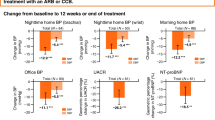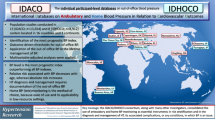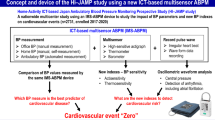Abstract
It has been reported that masked hypertension, a state in which patients show normal clinic blood pressure (BP) but elevated out-of-clinic BP by self-measured home BP, is a predictor of cardiovascular morbidity much like sustained hypertension. In addition, nocturnal BP is closely associated with cardiovascular disease. This might mean that ambulatory and self-measured home BP monitoring each provide independent information. We performed ambulatory BP monitoring, self-measured home BP monitoring, echocardiography and carotid ultrasonography in 165 community-dwelling subjects. We subclassified the patients according to the ambulatory and self-measured home BP levels as follows: in the masked nocturnal hypertension group, the self-measured home BP level was <135/85 mmHg and the ambulatory nocturnal BP level was ≥120/75 mmHg; in the normotensive group, the self-measured home BP level was <135/85 mmHg and the ambulatory nocturnal BP level was <120/75 mmHg. The intima-media thickness (IMT) and relative wall thickness (RWT) were greater in the masked nocturnal hypertension group than in the normotensive group (IMT: 0.76±0.20 vs. 0.64±0.14 mm, p<0.05; RWT: 0.50±0.14 vs. 0.41±0.10, p<0.05). Even in hypertensives with well-controlled self-measured home BP, elevated ambulatory nocturnal BP might promote target organ damage. We must rule out masked hypertension using self-measured home BP monitoring, and we might also need to rule out nocturnal masked hypertension using ambulatory BP monitoring.
Similar content being viewed by others
Article PDF
References
Pickering TG, Davidson K, Gerin W, Schwartz JE : Masked hypertension. Hypertension 2002; 40: 795–796.
Kawabe H, Saito I, Saruta T : Status of home blood pressure measured in morning and evening: evaluation in normotensives and hypertensives in Japanese urban population. Hypertens Res 2005; 28: 491–498.
Bjorklund K, Lind L, Zethelius B, Andren B, Lithell H : Isolated ambulatory hypertension predicts cardiovascular morbidity in elderly men. Circulation 2003; 107: 1297–1302.
Palatini P, Winnicki M, Santonastaso M, et al: Prevalence and clinical significance of isolated ambulatory hypertension in young subjects screened for stage 1 hypertension. Hypertension 2004; 44: 170–174.
Bobrie G, Chatellier G, Genes N, et al: Cardiovascular Prognosis of “masked hypertension” detected by blood pressure self-measurement in elderly treated hypertensive patients. JAMA 2004; 291: 1342–1349.
Verdecchia P, Porcellati C, Schillaci G, et al: Ambulatory blood pressure. An independent predictor of prognosis in essential hypertension. Hypertension 1994; 24: 793–801 [ published erratum appears in Hypertension 1995; 25: 462].
Ohkubo T, Imai Y, Tsuji I, et al: Relation between nocturnal decline in blood pressure and mortality. The Ohasama Study. Am J Hypertens 1997; 10: 1201–1207.
Staessen JA, Thijs L, Fagard R, et al: Predicting cardiovascular risk using conventional vs ambulatory blood pressure in older patients with systolic hypertension. JAMA 1999; 282: 539–546.
Sega R, Facchetti R, Bombelli M, et al: Prognostic value of ambulatory and home blood pressures compared with office blood pressure in the general population: Follow-Up Results from the Pressioni Arteriose Monitorate e Loro Associazioni (PAMELA) Study. Circulation 2005; 111: 1777–1783.
Nakano S, Ito T, Furuya K, et al: Ambulatory blood pressure level rather than dipper/nondipper status predicts vascular events in type 2 diabetic subjects. Hypertens Res 2004; 27: 647–656.
Tochikubo O, Ikeda A, Miyajima E, Ishii M : Effects of insufficient sleep on blood pressure monitored by a new multibiomedical recorder. Hypertension 1996; 27: 1318–1324.
Chobanian AV, Bakris GL, Black HR, et al: The Seventh Report of the Joint National Committee on Prevention, Detection, Evaluation, and Treatment of High Blood Pressure: the JNC 7 Report. JAMA 2003; 289: 2560–2571.
Lang RM, Bierig M, Devereux RB, et al: Recommendations for chamber quantification: a report from the American Society of Echocardiography's Guidelines and Standards Committee and the Chamber Quantification Writing Group, developed in conjunction with the European Association of Echocardiography, a branch of the European Society of Cardiology. J Am Soc Echocardiogr 2005; 18: 1440–1463.
Little P, Barnett J, Barnsley L, Marjoram J, Fitzgerald-Barron A, Mant D : Comparison of agreement between different measures of blood pressure in primary care and daytime ambulatory blood pressure. BMJ 2002; 325: 254.
Tachibana R, Tabara Y, Kondo I, Miki T, Kohara K : Home blood pressure is a better predictor of carotid atherosclerosis than office blood pressure in community-dwelling subjects. Hypertens Res 2004; 27: 633–639.
Nishinaga M, Takata J, Okumiya K, Matsubayashi K, Ozawa T, Doi Y : High morning home blood pressure is associated with a loss of functional independence in the community-dwelling elderly aged 75 years or older. Hypertens Res 2005; 28: 657–663.
Sega R, Trocino G, Lanzarotti A, et al: Alterations of cardiac structure in patients with isolated office, ambulatory, or home hypertension: data from the general population (Pressione Arteriose Monitorate E Loro Associazioni [PAMELA] Study). Circulation 2001; 104: 1385–1392.
Sumino H, Ichikawa S, Kasama S, et al: Effect of transdermal hormone replacement therapy on carotid artery wall thickness and levels of vascular inflammatory markers in postmenopausal women. Hypertens Res 2005; 28: 579–584.
Munakata M, Sakuraba J, Tayama J, et al: Higher brachial-ankle pulse wave velocity is associated with more advanced carotid atherosclerosis in end-stage renal disease. Hypertens Res 2005; 28: 9–14.
Masugata H, Senda S, Yoshikawa K, et al: Relationships between echocardiographic findings, pulse wave velocity, and carotid atherosclerosis in type 2 diabetic patients. Hypertens Res 2005; 28: 965–971.
Ishizaka N, Ishizaka Y, Toda E, Hashimoto H, Nagai R, Yamakado M : Hypertension is the most common component of metabolic syndrome and the greatest contributor to carotid arteriosclerosis in apparently healthy Japanese individuals. Hypertens Res 2005; 28: 27–34.
Salvetti M, Muiesan ML, Rizzoni D, et al: Night time blood pressure and cardiovascular structure in a middle-aged general population in northern Italy: the Vobarno Study. J Hum Hypertens 2001; 15: 879–885.
Verdecchia P, Schillaci G, Guerrieri M, et al: Circadian blood pressure changes and left ventricular hypertrophy in essential hypertension. Circulation 1990; 81: 528–536.
Shimada K, Kawamoto A, Matsubayashi K, Nishinaga M, Kimura S, Ozawa T : Diurnal blood pressure variations and silent cerebrovascular damage in elderly patients with hypertension. J Hypertens 1992; 10: 875–878.
Kario K, Pickering TG, Matsuo T, Hoshide S, Schwartz JE, Shimada K : Stroke prognosis and abnormal nocturnal blood pressure falls in older hypertensives. Hypertension 2001; 38: 852–857.
Eto M, Toba K, Akishita M, et al: Impact of blood pressure variability on cardiovascular events in elderly patients with hypertension. Hypertens Res 2005; 28: 1–7.
Cuspidi C, Lonati L, Sampieri L, et al: Left ventricular concentric remodelling and carotid structural changes in essential hypertension. J Hypertens 1996; 14: 1441–1446.
Verdecchia P, Schillaci G, Borgioni C, et al: Adverse prognostic significance of concentric remodeling of the left ventricle in hypertensive patients with normal left ventricular mass. J Am Coll Cardiol 1995; 25: 871–878.
Pickering TG, James GD, Boddie C, Harshfield GA, Blank S, Laragh JH : How common is white coat hypertension? JAMA 1988; 259: 225–228.
Palatini P, Mormino P, Santonastaso M, et al: Target-organ damage in stage I hypertensive subjects with white coat and sustained hypertension: results from the HARVEST study. Hypertension 1998; 31: 57–63.
White WB, Schulman P, McCabe EJ, Dey HM : Average daily blood pressure, not office blood pressure, determines cardiac function in patients with hypertension. JAMA 1989; 261: 873–877.
Nakashima T, Yamano S, Sasaki R, et al: White-coat hypertension contributes to the presence of carotid arteriosclerosis. Hypertens Res 2004; 27: 739–745.
Yamamoto Y, Akiguchi I, Oiwa K, Satoi H, Kimura J : Diminished nocturnal blood pressure decline and lesion site in cerebrovascular disease. Stroke 1995; 26: 829–833.
Hermida RC, Ayala DE, Calvo C, et al: Effects of time of day of treatment on ambulatory blood pressure pattern of patients with resistant hypertension. Hypertension 2005; 46: 1053–1059.
Author information
Authors and Affiliations
Corresponding author
Rights and permissions
About this article
Cite this article
Hoshide, S., Ishikawa, J., Eguchi, K. et al. Masked Nocturnal Hypertension and Target Organ Damage in Hypertensives with Well-Controlled Self-Measured Home Blood Pressure. Hypertens Res 30, 143–149 (2007). https://doi.org/10.1291/hypres.30.143
Received:
Accepted:
Issue date:
DOI: https://doi.org/10.1291/hypres.30.143
Keywords
This article is cited by
-
The Japanese Society of Hypertension Guidelines for the Management of Hypertension (JSH 2019)
Hypertension Research (2019)
-
Impact of obstructive sleep apnea and hypertension on left ventricular hypertrophy in Japanese patients
Hypertension Research (2017)
-
Perfect 24-h management of hypertension: clinical relevance and perspectives
Journal of Human Hypertension (2017)
-
Prehypertension in adolescents with cardiovascular risk: a comparison between type 1 diabetic patients and overweight subjects
BMC Research Notes (2016)
-
Chapter 2. Measurement and clinical evaluation of blood pressure
Hypertension Research (2014)



